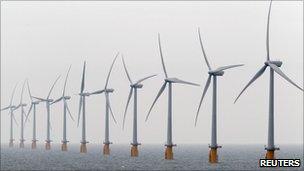Skykon impact on national plan 'not clear'
- Published

N-RIP will guide offshore renewables development in Scotland
The impact which turbine manufacturer Skykon's troubles will have on a national offshore renewable planning strategy are being examined.
The company, which produced towers for wind farms at a base in Argyll, has gone into administration.
The site it uses is among 11 key locations identified in planning document N-RIP Stage 2.
Highlands and Islands Enterprise (HIE) said potential effects on Stage 3 were not known at this stage.
N-RIP - the National Renewables Infrastructure Plan - is written by HIE and Scottish Enterprise.
Published in July last year, the stage 2 document, external identified the site at Machrihanish used by Skykon as a key location for the renewables industry.
The size of the former military air base - 1,025 acres (409 hectares) - and its close proximity to Campbeltown harbour were highlighted among its advantages.
N-RIP Stage 2 gives details on 10 other key locations for the manufacture and assembly of renewable devices.
They were Leith, Dundee, Nigg, Ardersier, Aberdeen, Peterhead, Hunterston, Arnish and Kishorn.
Under the plan, sites would work together in clusters named Forth/Tay, Moray Firth and Subsea and West Coast.
'Working closely'
N-RIP Stage 3 will include the results of discussions with the sites' owners.
HIE said: "Campbeltown/Machrihanish is one of the 11 strategic sites outlined in N-RIP, and a key part of the West Coast cluster.
"Whilst N-RIP Stage 2 refers specifically to Skykon, the prime importance and value are based upon the strategic location, facilities and infrastructure.
"We are currently working closely with the administrator and until the situation becomes clearer it is too early to say whether there will be any material impact on N-RIP."
Meanwhile, the Crown Estate has commissioned a report on its plans to develop the Pentland Firth and Orkney Waters, external for wave and tidal devices.
A spokeswoman said: "The Crown Estate has commissioned work to detail the 'Build Out' of the Pentland Firth and Orkney Waters projects.
"This will help potential suppliers, including local companies, government bodies and other organisations, by showing when and how the projects are expected to be built."
She added: "We plan to publish a report in the next few months."
- Published6 January 2011
- Published5 January 2011